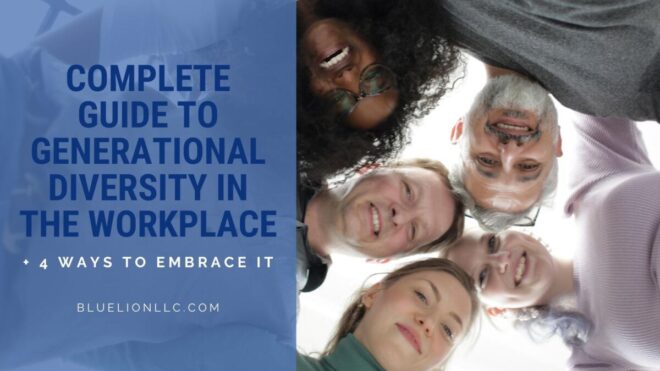
Many employers think of ethnicity, religion, and sexual orientation when it comes to diversity. They forget to recruit people from various age groups. But generational diversity is another key to ensuring diversity, equity, and inclusion (DEI) in your workplace — especially now that we have five generations working alongside one another!
Many employers think that hiring and managing employees of different generations will be challenging. After all, they all want different things and have different work and communication styles, right? How can you cater to all of their needs? Won’t team members from very different generational backgrounds butt heads?
That mindset is simply wrong. On the contrary, generational diversity in the workplace can help mitigate age discrimination and make your team stronger. Each generation brings unique perspectives, styles, and skillsets to the table. Why not take advantage of all of them?
Read on as we answer:
- What is generational diversity, and why is it important?
- What are the strengths, goals, and styles of each generation?
- How can employers foster and manage generational diversity?
What is generational diversity and why is it important?
An organization with true generational diversity employs and recruits talent from various age groups. This means your team consists of members from each generation: Silent Generation, Baby Boomers, Generation X, Generation Y (a.k.a. Millennials), and Generation Z.
Practicing generational diversity is a crucial step toward fighting ageism. All generations face age discrimination. For example, older candidates and employees may be viewed as technologically illiterate and averse to change, while younger adults are often perceived as lazy, lacking experience, and entitled.
In addition to tackling misconceptions about each age group, generational diversity can help your company grow through different perspectives. This can:
- Boost innovation and creative problem-solving.
- Promote career development.
- Improve employee retention.
- Provide vital insights into your audience, allowing you to deliver more effective marketing, product development, and customer service.
Everyone benefits when you practice generational diversity through your DEI initiatives, recruiting and hiring processes, and management techniques. Your brand will also resonate better with your target market.
An Overview of the 5 Generations
Below is a brief overview of the five generations currently in the workforce. These are generalized characteristics based on research. To prevent unconscious bias, do not rely on them when creating policies or hiring candidates.
The Silent Generation
Though they only make up 2% of the current U.S. workforce, the Silent Generation should not be forgotten. This group was born between 1925 and 1945 and wants to be respected, recognized, and know that they can impact their company long-term. Also known as Traditionalists, they value communication methods like handwritten notes.
Employers should provide Traditionalists with satisfying work and ways for them to contribute. They desire stability and are likely to remain loyal to your organization if you focus on these areas.
Baby Boomers
Born between 1946 and 1964, Baby Boomers are hardworking, goal-oriented, and team-oriented. This generation is often characterized as workaholics who prioritize efficiency and believe success requires sacrifice. According to Purdue University research, many are retiring later, with 65% planning to work past age 65.
Boomers want to be recognized for their achievements and thrive on goals, so managers should give them exactly that! Set specific milestones and deadlines, provide them with leadership and mentorship opportunities, and provide coaching-style feedback.
Generation X
Gen Xers were born between about 1965 and 1980 and will outnumber Baby Boomers by 2028! They are also the largest percentage of startup founders. Perhaps that reflects their independent and flexible nature. Generation X was the first to prioritize work-life balance and diversity in the workplace. Unlike Boomers, they are generally unwilling to sacrifice their personal lives for their work.
At the same time, this generation seems underappreciated, with Gen X leaders being the slowest to advance in their careers — despite being digitally savvy, collaborative, and loyal employees. Provide your Gen Xers with:
- Immediate feedback and external coaching
- Growth and advancement opportunities
- Flexible work arrangements and work-life balance
Millennials
The largest generation by population in the U.S., Millennials were born between about 1981 and 2000. Millennials desire a fun, open-minded work environment and probably won’t stick around at an organization inflexible to change. And they’re not afraid of switching jobs frequently to find work that challenges them, helps them grow, and allows them to use their skills to make a positive difference.
Employers should give their Gen Y employees fulfilling opportunities that maximize their potential. They value a personal connection, so managers should get to know their Millennial team members and manage by results. Build flexibility into their schedules and work assignments and provide immediate feedback, as Millennials are also achievement-oriented.
Generation Z
Born between 2001 and 2020, Generation Z is still emerging in the workplace. Wireless internet, smartphones, touchscreen devices, and apps have all been commonplace for this age group. Gen Z values diversity and inclusivity. They search for Millennial managers, innovative colleagues, and the latest tech.
Provide your Gen Zers with structured training, but allow them to be autonomous. They’ll also appreciate working on multiple projects simultaneously. While the youngest working generation wants work-life balance, they typically prioritize good pay. This differentiates them from Millennials, who often say they’d take a pay cut for better work-life balance and a job and company that aligns with their values.
4 Ways to Foster Generational Diversity in the Workplace
Shift Your Approach
Develop policies and benefits around where your employees are at in their lives. Remote work or flexible schedules, for example, can benefit many team members, including:
- Parents who need to take care of their children.
- Students taking college or professional courses.
- Employees who care for their aging parents or family members.
Eliminate Age Bias
Whether you don’t allow a young employee to lead a presentation because you don’t think they have the chops, or you don’t give an older employee a particular project because you don’t feel they can manage the technology, you could be depriving your company of valuable perspective. Additionally, actions like this open you up to lawsuits on the grounds of age discrimination.
Train your leadership or bring in an outside party to train your team and develop policies on preventing this discriminatory behavior.
Build & Retain Generationally Diverse Teams
Adjust your practices to focus on diversity through:
- Blind hiring (i.e., using a tool to hide identifiable traits from a candidate’s application irrelevant to their professional experience and skills)
- Skills testing for hiring and promoting people based on skills and knowledge rather than age.
- Mentoring and reverse-mentoring programs, so workers gain new perspectives.
Implementing these practices and programs will ensure you recruit the best person for each job and help you build a diverse workforce with various styles, strengths, and backgrounds. It will also help boost employee retention.
Offer Unique Benefits
All generations and demographics are searching for unique benefits nowadays, so why not create a benefits package that appeals to everyone? Again, consider the life stages of your different employees. Survey your employees and ask questions like:
- What kind of flexibility are they looking for?
- What are their primary health and wellness concerns?
- Where can you help them save time and find more work-life balance?
- What type of financial and compensation programs do they want?
Offering a comprehensive benefits and compensation package will attract and retain your top talent. You’ll also find that many benefits will help and support everyone’s lifestyles.
While establishing generational diversity in your workplace may seem challenging, it doesn’t need to be! With the right processes and policies in place — and the right mindset — hiring people at different stages in life will result in a more vital, vibrant organization.
If you need guidance on catering to each generation or ways to build on generational diversity in your company, BlueLion can help! We will provide diversity training, audit your policies, review your hiring and career advancement practices, and help you enact new systems and methods. Call us at 603-818-4131 or email info@bluelionllc.com to learn more today!
The information on this website, including its newsletters, is not, nor is it intended to be legal advice. You should contact an attorney or HR specialist for advice on your individual situation.


